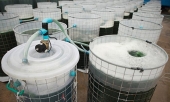
 1
1




Charlotte Anthony
The Mother Who Plants Trees
http://www.handsonpermaculture1.org
victorygardensforall@gmail.com








Charlotte Anthony
The Mother Who Plants Trees
http://www.handsonpermaculture1.org
victorygardensforall@gmail.com









Charlotte Anthony
The Mother Who Plants Trees
http://www.handsonpermaculture1.org
victorygardensforall@gmail.com
 4
4




Makin' lotsa mistakes




Charlotte Anthony
The Mother Who Plants Trees
http://www.handsonpermaculture1.org
victorygardensforall@gmail.com




Makin' lotsa mistakes




Thekla McDaniels wrote:As Juan says, anaerobic fermentations, whether teas or piles, create substances toxic to plants. The decomposition of your weeds or grass clippings is where this thread starts, but there are micro-organisms participating in the decomposition process. Which micro organisms is determined by the conditions in the broth/pile. The anaerobic organisms make some lethal things, and gasses are lost to the atmosphere as well. Since we all breathe it, my bias is to keep it clean
Thekla




This is all just my opinion based on a flawed memory

 2
2








I use this kind of method quite a lot especially with weeds that have gone to seed or have resilient roots (the idea is that, since I only practice cold composting, seedy weeds or persistent roots would survive in the compost heap). I let the vegetable matter rot completely in the water, and eventually the resulting slimy liquid becomes quite smelly. This is accomplished in 2-3 weeks. All the seeds and roots rot together with the rest of the plant and are no longer viable. After you use the liquid as feed, you can dump the remaining vegetable matter onto your compost heap.

 1
1




Ben Zumeta wrote:I have found leaf mold or finished compost sprinkled on top of the brew bucket can help reduce odors greatly.
- Tim's Homestead Journal - Purchase a copy of Building a Better World in Your Backyard - Purchase 6 Decks of Permaculture Cards -
- Purchase 12x Decks of Permaculture Cards - Purchase a copy of the SKIP Book - Purchase 12x copies of Building a Better World in your Backyard

 4
4




Alina Green wrote:This guy appears to have tested the nutrients NPK in "weed tea" and also mentions a paper on similar liquid fertilizer made in Zimbabwe from plants. (you can find the paper by searching online)
Hans Albert Quistorff, LMT projects on permies Hans Massage Qberry Farm magnet therapy gmail hquistorff
 2
2




Hans Quistorff wrote: The main benefit in adding it to dirt as previous posts highlighted is adding soil life. ...In fact what I do is pour the liquid on the soil and leave the plant residue on top for mulch.
 1
1




Alina Green wrote:This guy appears to have tested the nutrients NPK in "weed tea" and also mentions a paper on similar liquid fertilizer made in Zimbabwe from plants. (you can find the paper by searching online)
https://www.youtube.com/watch?v=tB7cxfzPFQc
This is all just my opinion based on a flawed memory

 1
1




Ben Zumeta wrote:
Alina Green wrote:This guy appears to have tested the nutrients NPK in "weed tea" and also mentions a paper on similar liquid fertilizer made in Zimbabwe from plants. (you can find the paper by searching online)
https://www.youtube.com/watch?v=tB7cxfzPFQc
That guy also endorses the use of chemical fertilizers instead of compost teas, and does seem to miss the point about how soil life chelates and cycles nutrients for much higher efficiency per unit of NPK etc. I’d never trust a “garden expert” wearing a tux!
 1
1















 1
1




If someone more astute can translate the study, I'd appreciate it. https://www.frontiersin.org/journals/environmental-science/articles/10.3389/fenvs.2018.00139/full
Hans Albert Quistorff, LMT projects on permies Hans Massage Qberry Farm magnet therapy gmail hquistorff
 4
4




Best luck: satisfaction
Greatest curse, greed
 4
4




 4
4




Zone 6, 45 inches precipitation, hard clay soil





|
I don't like that guy. The tiny ad agrees with me.
12 DVDs bundle
https://permies.com/wiki/269050/DVDs-bundle
|



